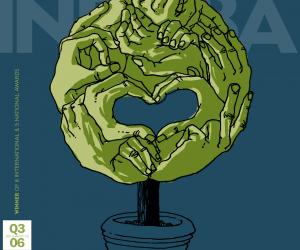First Published in
Botanical illustration may be an age-old art, first employed by explorers and colonialists, but it is not an ageing one. Rather than be rendered redundant with the advent of macro lenses and close-up photography, botanical art remains instead the preserve of botanists who know very well that celluloid and pixels can never quite capture the clarity, colour, luminescence, steady focus, and verity of that human lens known as the artist's eye.
A botanical drawing is far more than just a pretty flower picture - despite first appearances. Precisely measured, earnestly observed and immaculately studied, a botanical illustration must strive to present the most ideal aspect of a plant, a perfect and unblemished specimen.
It is, after all, an identification guide for botanists. Botanical illustrators collaborate closely with botanists who bring them the background information and fresh specimens they must so deftly depict. Working to a life-size scale, an artist usually employs a loose knowledge of botany and has less than 40 hours to complete a drawing while the plant "starts wilting right before your eyes," says Cape Town-based illustrator Karen Stewart. It's an exacting sport masquerading as an art form.
The objective of the botanical illustrator is to "take nature's challenge and reproduce it as perfectly and scientifically as possible," explains local artist Lisa Strachan. Lisa, whose work is pictured here, specializes in rare South African plants, and it is interesting to compare her renditions with the graphic offering presented by photographer Clinton Friedman (also pictured in this issue).
Lisa's work has been widely exhibited and collected in South Africa and the UK, USA, Europe, Ireland and Australia. She currently works closely with the resident succulent expert at the Kirstenbosch Botanical Gardens, Ernst van Jaarsveld.
Her career first started to bloom in 2002 when she became the youngest recipient ever to receive a bronze medal at the Biennale Exhibition of Kirstenbosch, organised by the Botanical Society of South Africa.
In 2002, 2003 and 2006, Lisa was selected to exhibit at Filoli (yes, the set of Dynasty) in San Francisco, an historic site that is dedicated to horticulture, art, architecture, decorative art and floral design. The Filoli annual botanical art exhibition attracts a pool of international artists from as far afield as Australia and the UK. Lisa has also been invited to exhibit in London, with the Royal Horticultural Society, and was awarded a silver medal for her showing.
Most recently, three of her designs were purchased by the UK porcelain company Churchill China, and are due to be released globally on a set of mugs. Soon, no matter where you are in the world, you'll be able to raise an indigenous South African agapanthus, strelitzia or erica to your lips.
Botanical illustration may be an age-old art, first employed by explorers and colonialists, but it is not an ageing one. Rather than be rendered redundant with the advent of macro lenses and close-up photography, botanical art remains instead the preserve of botanists who know very well that celluloid and pixels can never quite capture the clarity, colour, luminescence, steady focus, and verity of that human lens known as the artist's eye.
A botanical drawing is far more than just a pretty flower picture - despite first appearances. Precisely measured, earnestly observed and immaculately studied, a botanical illustration must strive to present the most ideal aspect of a plant, a perfect and unblemished specimen.
It is, after all, an identification guide for botanists. Botanical illustrators collaborate closely with botanists who bring them the background information and fresh specimens they must so deftly depict. Working to a life-size scale, an artist usually employs a loose knowledge of botany and has less than 40 hours to complete a drawing while the plant "starts wilting right before your eyes," says Cape Town-based illustrator Karen Stewart. It's an exacting sport masquerading as an art form.
The objective of the botanical illustrator is to "take nature's challenge and reproduce it as perfectly and scientifically as possible," explains local artist Lisa Strachan. Lisa, whose work is pictured here, specializes in rare South African plants, and it is interesting to compare her renditions with the graphic offering presented by photographer Clinton Friedman (also pictured in this issue).
Lisa's work has been widely exhibited and collected in South Africa and the UK, USA, Europe, Ireland and Australia. She currently works closely with the resident succulent expert at the Kirstenbosch Botanical Gardens, Ernst van Jaarsveld.
Her career first started to bloom in 2002 when she became the youngest recipient ever to receive a bronze medal at the Biennale Exhibition of Kirstenbosch, organised by the Botanical Society of South Africa.
In 2002, 2003 and 2006, Lisa was selected to exhibit at Filoli (yes, the set of Dynasty) in San Francisco, an historic site that is dedicated to horticulture, art, architecture, decorative art and floral design. The Filoli annual botanical art exhibition attracts a pool of international artists from as far afield as Australia and the UK. Lisa has also been invited to exhibit in London, with the Royal Horticultural Society, and was awarded a silver medal for her showing.
Most recently, three of her designs were purchased by the UK porcelain company Churchill China, and are due to be released globally on a set of mugs. Soon, no matter where you are in the world, you'll be able to raise an indigenous South African agapanthus, strelitzia or erica to your lips.











